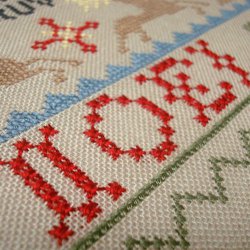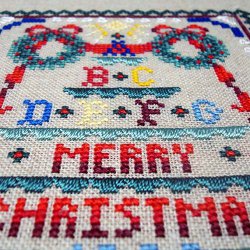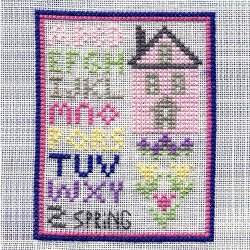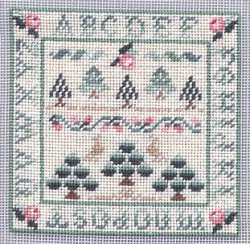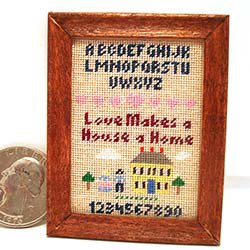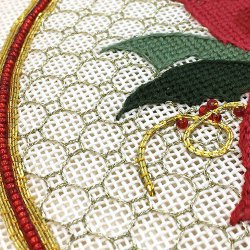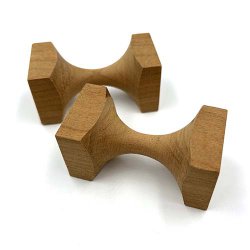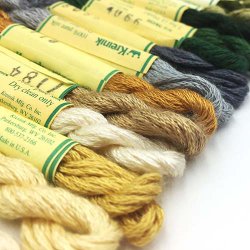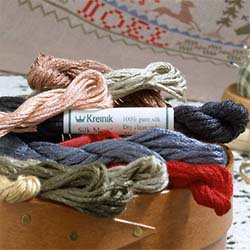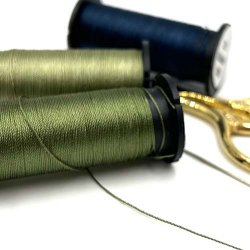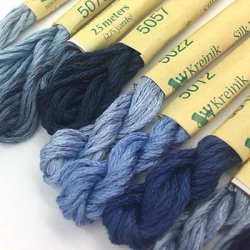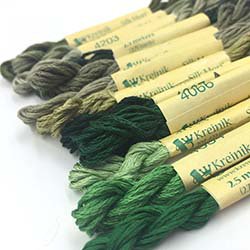- Shop Fly Fishing
-
Shop Needlework
- Metallic Threads
- Silk Threads
- Kits & Sets
- Accessories
- Free Patterns
- How To
36 products found
Sort by:
Recommended
Shop Needlework > Free Patterns > Cross Stitch > Cross Stitch Christmas
-
Seasonal Celebration Sampler
Note: This item is not shipped; the pattern is a PDF you download onto your computer or device
Designed by Kandace Thomas
Skill Level: IntermediateThis is one of our most popular designs we've ever published. Originally created for a Christmas advertisement in a Just Cross Stitch magazine issue, we proudly present it here for your stitching pleasure. If you start now, you can have it finished for this year's holiday.
Materials needed:
- one 2.5m skein of Kreinik Silk Mori® in these colors: 1117, 4203, 9034, 7086
- one 5m skein of Kreinik Silk Mori® in these colors: 8077, 7134, 5055, 4206
- 28-count natural linen, about an 18" x 13" piece (stitch count is 81h x 153w)
- #24 Tapestry needle
Instructions:
This design is primarily stitched using the Cross Stitch, with Smyrna crosses forming the "Noel" and one band of Long-arm Cross stitch beneath the "Noel." Use two strands of Silk Mori for all stitches. Each square on the chart represents two fabric threads.
Tips: Separate strands of Silk Mori by removing the paper wrapper and loosening the slip knot holding the thread ends together.Cut a 15- to 18-inch length and remove one ply at a time, straightening the thread after removing each ply to avoid tangling. Let your needle hang frequently as you stitch so the the thread can relax. Lay your stitches carefully and neatly; make sure the two strands of each stitch are lying parallel to maximize the beautiful, unique lustre of silk thread.
Printing Instructions:
Click here to download the FREE instructions for this design. You will need the Adobe Reader to view and print this file.
-
Christmas Sampler in Silk
Note: This item is not shipped; the pattern is a PDF you download onto your computer or device
Designed by: Angela Pullen
Skill Level: Intermediate
Stitch Count: 101h x 73wWe're bring back a Kreinik Classic from a few years ago-it's one of our most popular freebie designs ever. This elegant project uses beautiful holiday colors of Silk Mori and Silk Serica, both easy to use and ideal for heirloom projects. change the date for this year's holiday or for next year.
Materials needed:
- One 1/2 Skein (2.5m) of Kreinik Silk Mori® in each color: 4164, 4166, 1114, 1117, 5093, 5095, 5097, 7124, 2024, 2026
- Two 1/2 Skeins (2.5m) of Silk Mori in each color: 4167, 1119
- One reel of Kreinik Silk Serica® in each color: 7124, 4163, 4166
- 15" x 17" piece of 28-ct Natural Linen
- Scroll frame, stretcher bars, or Q-snaps
- #24 Tapestry Needle
Instructions:
Cross Stitch this design over two threads centered on your fabric. Each square on the chart equals two fabric threads. Follow the color key for cross stitch areas. Use two strands of Silk Mori for cross stitches.
Specialty stitch areas:
- 1. Four-Sided Stitch using two strands of Silk Mori 4167
- 2. Fanned Satin Stitch using Silk Serica 7124
- 3. Satin Stitch using Silk Serica 4163
- 4. Satin Stitch using Silk Serica 4166
- 5. Satin Stitch using Silk Serica 4163
- 6. Satin Stitch using Silk Serica 4166
- 7. Satin Stitch using Silk Serica 4163
- 8. Rice Stitch using two strands of Silk Mori 1117 on the bottom and one strand of Silk Mori 4167 on the top
- 9. Algerian Eyelet using Silk Serica 7124 (in the areas indicated by the squares)
Special Notes:
- Make French Knots on the holly berries at symbol with two strands of Silk Mori 7124
- Add French Knots in various places on the wreaths to make red berries using two strands of Silk Mori 1117
- Do not separate Silk Serica into strands. Use it as it comes, straight from the reel.
Printing Instructions:
Click here to download the FREE instructions for this design. You will need the Adobe Reader to view and print this file.
Shop Needlework > Free Patterns > Cross Stitch > Cross Stitch For All Seasons
-
Mini Spring Silk Sampler
Note: This item is not shipped; the pattern is a PDF you download onto your computer or device
Spring Sampler- A Kreinik website design by Judy Lalanne
- Skill Level: Beginner
- Stitch Count: 53 h x 41 w
Stitch over two threads centered on the linen, using one strand of Silk Mori for all cross stitches following the color key below. Use one strand of Silk Mori 8075 to backstitch the word "Spring", and one strand of Silk Mori 4033 to backstitch the flower stems.
Materials needed:
- Kreinik Silk Mori®, one 1/2 Skein" of each color: 5097, 1054, 2024, 4033, 1032, 8053, 6106, 8075
- 35-ct. White Northern Cross Linen at least 7" x 8" (you can also use a 32-count linen)
Instructions:Click here to download the FREE instructions for this design. You will need the Adobe Reader to view and print this file.
Shop Needlework > Free Patterns > Dollhouse Miniatures
-
Miniature Silk Gauze Christmas Sampler
NOTE: this item is not shipped. Click the link below to download the PDF.
Miniature Christmas Sampler — a PETIT POINT silk gauze project- Designed by Carol Emmer
Stitch Count: 76w x 76h
What a peaceful way to prepare for the holidays-spending time stitching this classic design with silk threads on silk gauze. Take a moment for yourself as you run errands, plan meals, and do all of those things that can overwhelm us this time of year. Spend time stitching something, unhurried, and thinking of the meaning of the season for you and your family.
Materials needed:
- 4"x 4" piece of 40-ct Kreinik silk gauze
- Kreinik Silk Mori®, one 2.5m skein of each: 3017 Very Dark Coral, 3015 Medium Coral, 3013 Light Coral, 3011 Very Light Coral, 7124 Cream, 4166 Dark Victorian Green, 4164 Medium Victorian Green, 4163 Light Victorian Green, 7135 Medium Dark Mocha, 7134 Medium Bark, 7133 Light Bark,4167 Very Dark Victorian Green
Instructions:
Click here to download the FREE instructions for this design.You will need the Adobe Reader to view and print this file.
- Designed by Carol Emmer
-
Love Makes a Home silk gauze sampler
NOTE: This item is not shipped. Click the link below to download the PDF.
Love Makes a House a Home PETIT POINT project
by Terrie Lyn Nutter
- An antique sampler exhibit at the Baltimore Museum of Art once displayed a needlework piece stitched by a young American girl in the late 1800s. It was stitched on a piece of gauze that had previously been wrapped around the wounds of a Civil War soldier hurt in a battle near her family's home. Imagine the stitches of silk thread embroidered on the transparent, thin, almost gossamer gauze. The stitches seemed to hang in the air.
This translucent, dimensional effect is one of the beauties of silk gauze embroidery, used throughout the centuries and growing in popularity today for petit point needlework and miniatures.
What is silk gauze?
Silk gauze is a 100% pure filament silk canvas. The silk threads are fine but very strong. Silk gauze is woven in a leno structure, which increases the stability of the canvas. Leno weave actually interlocks the weft threads making it almost impossible for them to shift. It comes in various sizes, including 18-count, 32-count and 40-count.
When do you stitch on silk gauze?
Stitch on silk gauze anytime you want a small, delicate piece of needlework. Miniaturists and doll house enthusiasts enjoy silk gauze needlepoint pieces because you can achieve realistic looking items. For example, doll house rugs, pillows, pictures, and bell pulls can be stitched to scale: 40-count silk gauze is perfect for 1-inch to 1-foot scale.
Silk gauze work is also now gaining popularity among cross stitchers and needlepointers looking for something different (aren’t we all attracted by miniature things?).
How do you stitch on silk gauze?
The first step in stitching on silk gauze is choosing a project. Almost any charted cross stitch design can be used for silk gauze needlepoint. Here you can stitch Love Makes a House a Home for a project. Designs without quarter stitches, blended colors, backstitches, or elaborate color changes make the most successful silk gauze needlepoint projects. You stitch over one thread on silk gauze.
Continental (tent) stitch is the appropriate stitch for silk gauze because it makes for smooth, even silk gauze needlework. Also, it is easier to stitch tent through such petite holes. The use of tent stitch, for example, will have a maximum of two threads in a hole whereas cross stitch could have as many as four stitches per hole. Generally, you stitch with silk threads on silk gauze.
Stitching tips
Sharp scissors, good lighting, and magnifiers can make stitching on silk gauze a breeze.Starting at the top of a chart makes it easier to keep your place on the chart while stitching. A magnet board will also help, or simply cross out stitches on the chart that have been completed as you go along.
Choosing the appropriate needle for silk gauze is also important, as using a needle that is too large can distort the canvas. For 18-count silk gauze, for example, you would use a #26 Tapestry needle with 3 strands of Silk Mori. ON 32-mesh, use a #28 Tapestry with two strands of Silk Mori. On the very fine 40-count, used in this design, Terrie Lynn Nutter recommends a #10 Crewel needle with one strand of Silk Mori.
When stitching on silk gauze, a neat back is especially important if some of the background is left unstitched. When starting a thread, try to use an ‘away waste knot’ to begin. You may sometimes be able to end a thread using this same technique, resulting in less bulk on the back of your work. When ending threads by ‘running’ under stitches, use caution so that the tension of the stitches is not changed.
A dark piece of cloth behind your work makes the holes of the silk gauze ‘pop’ and you can see the threads that need to be covered.
Materials needed:
- Kreinik Silk Mori in 8050, 7012, 7133, 1033, 1032, 2024, 4036, 5095, 8000, 7126, 5093, 5057, 1119, 3017, 8075
- Kreinik 40-count silk gauze, framed, at least 3" x 5" size
- #10 crewel needle
Instructions:
Download the graph and color key for this design by clicking on the PDF below. Stitch this design on the gauze using one strand of Silk Mori according to the color key in continental (tent) stitch. Follow the stitching tips above. Silk gauze work is not necessarily fast stitchery, but it is rewarding. And many will admire your creation. Enjoy.
Click here to download the FREE instructions for this design.You will need the Adobe Reader to view and print this file.
Shop Needlework > How To > Metallic Thread
-
How to use Kreinik Cable
Cable is like stitching with a tiny rope. It is highly texturized, resembling a real metal thread but made of synthetic materials not real metals. Use it to add elegance to a design, and when your project has specialty stitches that can show off Cable's texture.
Applications:
Crazy quilting (hand and machine), crewel, cross stitch/counted thread, costume making, doll making (hand and machine), hardanger, machine embroidery/couching, miniatures, needlepoint/canvas work, punch embroidery, ribbon embroidery (by hand and machine), stumpwork.
Hand EmbroideryThis thread is ideal for creating background patterns on canvas. On fabric, it is often used for decorative stitches or outlines, as in samplers. Resembling real gold or silver, it has a classic elegance and refined line. It is too thick and stiff to use in cross stitch or tent stitch...longer stitches that can show off it's twist are better.
CareKreinik Cable is hand or machine washable and dry cleanable. Cool water is recommended. Do not use bleach. It can also be tumble-dried on low setting. When ironing a finished piece containing Cable, do not iron directly on the thread; use a cloth, and do not use steam.
Tips on using Kreinik Cable in hand work:- Stitch slowly with Cable to achieve more control and insure uniformity in stitching.
- Let your needle hang frequently to let the thread untwist if you have recurring problems with tangling and knotting.
- Use short lengths of cable-about 45cm (18 inches) or less-to avoid excessive wear on the thread and for greater control (less knotting!).
-
How to use a Koma
Need another pair of hands? Komas come to the rescue.
What is a Koma?
This wooden spool serves as an extra "hand" to hold threads you are couching on the surface of your fabric or canvas. Originally used in Japanese embroidery, komas are used world-wide by stitchers of all ages and skill levels. Kreinik's Komas are made in Ohio, turned with West Virginia and Ohio wood.
What is couching?
Couching is a surface embroidery technique in which you tack down a decorative thread with an invisible, coordinating, or contrasting thread. These tacking stitches can be either side to side, down the middle of your couched thread, or a decorative stitch such as Herringbone, Elongated Cross, etc.
Couching is a traditional Japanese embroidery technique that has become popular in all needlework and crafts today, including counted thread, needlepoint, quilting, crazy quilting, surface embroidery, stumpwork, goldwork, crewel, and samplers. Komas are an easy way to hold — and direct — your couching threads as you stitch.
Which threads can be couched?
Couching is an excellent way to use threads that are too thick to pass through fabric or canvas, however you can couch any decorative thread: real metal, metallic, silk or ribbon. Kreinik threads you can couch include Japan #5, Japan #7, 1/8" Ribbon, 1/16" Ribbon, Facets, Petite Facets, Micro Ice Chenille, Heavy #32 Braid, Canvas #24 Braid, Medium #16 Braid, Silk Serica, and Kreinik Real Metal Threads. Kreinik threads that you use to couch these decorative threads include Silk Bella, Silk Mori, Silk Couching Thread, Japan #1, Cord, Blending Filament, Very Fine #4 Braid, Fine #8 Braid.
Why does the koma have square ends?
They prevent the spools from rolling around or off your project as you stitch.
How do you use a koma?
Wrap your decorative thread around the barrel of the koma, then set it on your needlework to unwind the thread as you couch. Move the koma as you work to keep your thread in proximity to your stitching area. This gives you greater control over your couching, and the wooden spools won't roll off as you work.
Why are komas sold in pairs?
Having two komas allows you to couch more than one thread at a time. This creates exciting embroidery effects and expands your creative options: imagine the dimension you can achieve by layering fibers like round Fine #8 Braid on top of flat 1/8” Ribbon, or placing them parallel as in two rows of smooth gold Japan #5. You can create new textures, trims, borders, and edgings by couching multiple threads, and komas make couching easier.
Shop Needlework > How To > Silk Thread
-
How to use Kreinik Silk Mori®
Kreinik Silk Mori® is a 6-strand spun silk. That means:
- as a spun silk, it has a creamy natural luster (as opposed to a filament silk, which has a bright sheen)
- you can separate the strands and recombine to suit whatever your stitch is on whatever fabric or canvas you're using—two strands of Silk Mori is ideal for cross stitch on 14-count Aida, for instance.
- you can use it in place of cotton embroidery floss, when you want to elevate a design (creating an heirloom), when you want to show off the beautiful natural sheen of silk (like in samplers), or simply when you want to spoil your eyes and your fingers (it's so soft!)
Read the Description below for stitching tips and usage ideas for Kreinik Silk Mori.
-
Silk Thread History
Since it was first processed in China, silk thread has been used in embroidery for more than 5,000 years. Silk is an animal fiber made from the viscous fluid of the silkworm. Originally, silkworm cocoons were collected from trees. In 2640 B.C., a Chinese Empress discovered that if a silk cocoon was placed in hot water to soften the natural glue or sericin (holds the cocoon together), then a silk cocoon could be unwound and stretched into a long filament. Fo Xi, China's first Emperor, taught the Chinese people to cultivate mulberry trees and raise silkworms.
The first variety of silkworm to be domesticated was the Bombyx Mori. Over the centuries, at least thirteen other species have been cultivated. In addition, there are more than 80 varieties of wild silkworms. In the history of needlework, silk was a primary thread for embroidery, used in tapestries and garments, blackwork, and samplers. When the world was at war in the beginning of the 1940's, however, the silk supply literally dried up overnight. Chemical companies developed synthetic fibers commercially, and these fibers replaced silk almost instantly. As a result, for more than fifty years, people have looked upon silk as rare, expensive and delicate.
Today, embroiderers acknowledge silk for its practical and lustrous qualities. The translucent cellular structure of silk allows it to absorb dyes and to reflect light to a high degree, giving the finished product a pure color and a beautiful luster. When worked in specialty stitches and laid properly, silk has a bright sheen unrivaled by other threads. Due to the different cellular structures of silk and cotton, for example, silk is very smooth while cotton is fuzzy.
Silk also remains lustrous and strong over time, while cotton loses its luster and strength. Archaeologists found that silk in China, buried in tombs for 3,000 years, was the only fiber that remained intact and recognizable. Also, in Sweden, while dredging a channel in the harbor where an old warehouse had burned, black silk skeins buried under mud for 27 years were discovered. After cleaning, they found that the color, strength, and lustre still remained.
Choose silk thread for its unparalleled lustre, texture, and elegance. It adds a richness that raises your needlework to a higher level. Whether used in sampler work, needlepoint, or other techniques, silk threads enable needleworkers to play with light and with textures in their stitchery. It is an affordable thread that is perfect for treasured, keepsake needlework. Its softness, too, makes silk the ultimate in luxurious stitching enjoyment.
-
How to use Kreinik Silk Bella™
Silk Bella™ is the thinnest of the Kreinik silk threads. It is a filament silk with a bright sheen, visible in designs even with it's small weight. It is a beautiful thread when used in any stitch, in any technique. Silk Bella is dyed in colors to match Silk Mori® and Silk Serica®.
Content: 100% pure filament silk
Care
Silk Bella should only be dry cleaned. Do not wash or wet block silk work. Do not use an embroidery hoop with silk thread in hand stitchery, as the rings, markings or folds left in the fabric cannot be removed by washing the piece. Instead, use stretcher bars, Q-snaps, or scroll frames.
Applications
Appliqué (hand and machine), blackwork, costume making, crazy quilting (hand and machine), crewel, crochet, cross stitch/counted thread, couching, doll making (hand or machine), hardanger, Japanese embroidery, knitting, lace making, machine embroidery/bobbin work, machine embroidery/couching, miniatures, needlepoint/canvas work, punch embroidery, ribbon embroidery (hand and machine), smocking, stumpwork, weaving.
Hand Embroidery, Cross Stitch, Samplers, Needlepoint
Silk Bella is ideal for a variety of stitches in samplers, hardanger, crewel, stumpwork, pulled work, crazy quilting, petit point, and needlepoint or canvas work. Use it straight from the reel as a 3-ply twisted thread for tent stitch, satin stitch, kloster blocks and other stitches that showcase its texture. It is similar in weight to a #12 Pearl Cotton. Do not separate strands; use as is, straight off the reel.
Tips on using Silk Bella
- To keep your stitching looking its best, take time to wash your hands before stitching. Use a non-greasy hand cream to moisturize hands and prevent the silk from snagging on dry skin or cuticles.
- Prepare your ground material (fabric or canvas) prior to stitching to prevent the silk from snagging on rough edges. Turn the edges under with a running stitch, or cover the edges with tape.
- Silk Bella® comes on a snap-spool mechanism. Both sides of the spool open; look for the side where the thread end is located. Insert your thumbnail under the cap, and rotate the spool while gently lifting the cap to release the thread (the cap should not pop off). Snap the lid shut to secure the unused portion.
- Use lengths of silk no longer than 45cm (18 inches) for better thread control and reduced thread abrasion from repeated passes through the ground material. Use a needle large enough to 'open' the hole in the fabric to allow the silk thread to go through easily.
- It is important to maintain Silk Bella's twist as it comes from the spool to ensure uniform stitches from beginning to end. Since all of us as stitchers twist our needles a little bit while stitching, apply a slight reverse twist to your needle, or allow your needle to dangle every one or two stitches. This will prevent the softly twisted silk from untwisting or becoming too tightly twisted.
Shop Needlework > Kits & Sets > Silk Thread Sets > Italian Silk Sets
-
Blue Italian Silk Set
Color stash of the softest, most beautiful silk floss for your stitching pleasure. This 100% pure spun silk is used in samplers, embroidery, cross stitch, needlepoint, crazy quilting, punchneedle, and more. Each set contains twelve 2.5-meter skeins. Perfect for starting your silk thread addiction.
This set includes the following Silk Mori® colors: 5012, 5014, 5016, 5022, 5053, 5055, 5057, 5073, 5093, 5095, 5097, 5103
-
Green Italian Silk Set
Color stash of the softest, most beautiful silk floss for your stitching pleasure. This 100% pure spun silk is used in samplers, embroidery, cross stitch, needlepoint, crazy quilting, punchneedle, and more. Each set contains twelve 2.5-meter skeins. Perfect for starting your silk thread addiction.
This set includes the following Silk Mori® colors: 4033, 4034, 4037, 4066, 4067, 4074, 4076, 4077, 4203, 4204, 4206, 4212


